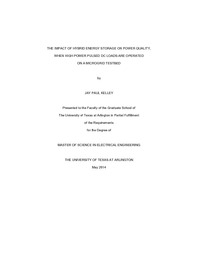
ATTENTION: The works hosted here are being migrated to a new repository that will consolidate resources, improve discoverability, and better show UTA's research impact on the global community. We will update authors as the migration progresses. Please see MavMatrix for more information.
Show simple item record
| dc.contributor.author | Kelley, Jay Paul | en_US |
| dc.date.accessioned | 2014-07-14T20:30:40Z | |
| dc.date.available | 2014-07-14T20:30:40Z | |
| dc.date.issued | 2014-07-14 | |
| dc.date.submitted | January 2014 | en_US |
| dc.identifier.other | DISS-12586 | en_US |
| dc.identifier.uri | http://hdl.handle.net/10106/24482 | |
| dc.description.abstract | As the Navy's demands for high power transient loads evolves, so too does the need for alternative energy sources to back-up the more traditional power generation. Such applications in need of support include electrical grid backup and directed energy weapon systems such as electromagnetic launchers, laser systems, and high power microwave generators, among others. Among the alternative generation sources receiving considerable attention are energy storage devices such as rechargeable electrochemical batteries and capacitors. In such applications as those mentioned above, these energy storage devices offer the ability to serve a dual role as both a power source to the various loads as well high power loads themselves to the continual generation when the high power transient loads are in periods of downtime. With the recent developments in electrochemical energy storage, lithium-ion batteries (LIBs) seem like the obvious choice, but previous research has shown that the elevated rates of charging can be detrimental to both the cycle life and the operational life span of the device. In order to preserve the batteries, their charge rate must be limited. One proposed method to accomplish the dual role task mentioned above, while preserving the life of the batteries, is by combining high energy density LIBs with high power density electric double layer capacitors (EDLCs) or lithium-ion capacitors (LICs) using controllable power electronics to adjust the flow of power to and from each device. Such a configuration is typically referred to as hybrid energy storage module (HESM). While shipboard generators start up, the combined high energy density and high power density of the HESM provides the capability to source critical loads for an extended period of time at the high rates they demand. Once the generator is operationally efficient, the HESM can act as a high energy reservoir to harvest the energy from the generator while the loads are in short periods of inactivity. This enables the generator to maintain its operation at levels of high efficiency thereby increasing the power quality of the AC bus. The work discussed here is aimed at evaluating how the use of energy storage impacts the power quality on MicroGrid's AC bus when high rate DC and AC loads are sourced simultaneously. Also HESM has been developed and evaluated as a mean to optimizing both the power and energy density of the energy storage installed. | en_US |
| dc.description.sponsorship | Wetz Jr., David A. | en_US |
| dc.language.iso | en | en_US |
| dc.publisher | Electrical Engineering | en_US |
| dc.title | The Impact Of Hybrid Energy Storage On Power Quality When High Power DC Loads Are Operated On A Microgrid Testbed | en_US |
| dc.type | M.S. | en_US |
| dc.contributor.committeeChair | Wetz Jr., David A. | en_US |
| dc.degree.department | Electrical Engineering | en_US |
| dc.degree.discipline | Electrical Engineering | en_US |
| dc.degree.grantor | University of Texas at Arlington | en_US |
| dc.degree.level | masters | en_US |
| dc.degree.name | M.S. | en_US |
Files in this item
- Name:
- Kelley_uta_2502M_12586.pdf
- Size:
- 3.767Mb
- Format:
- PDF
This item appears in the following Collection(s)
Show simple item record


